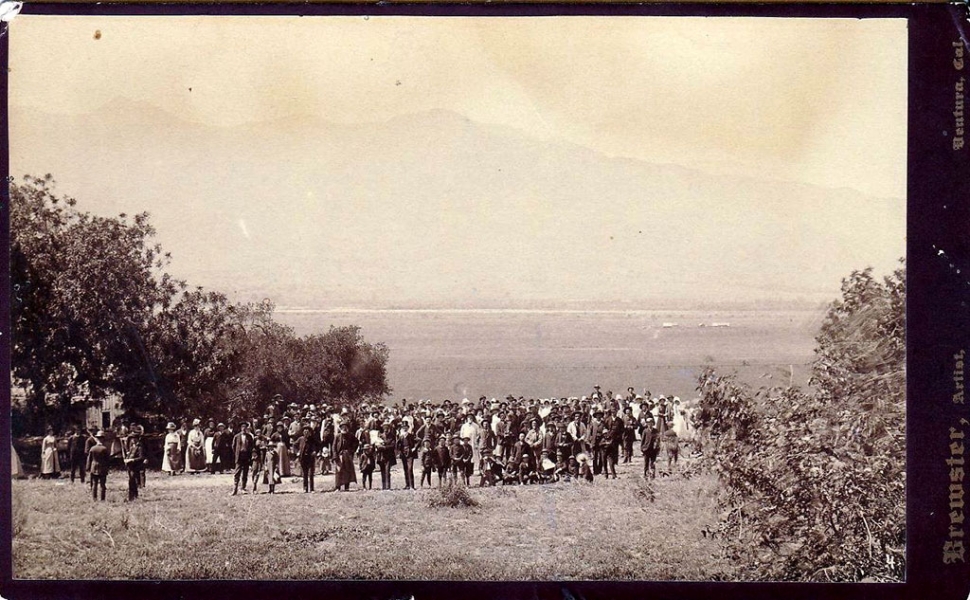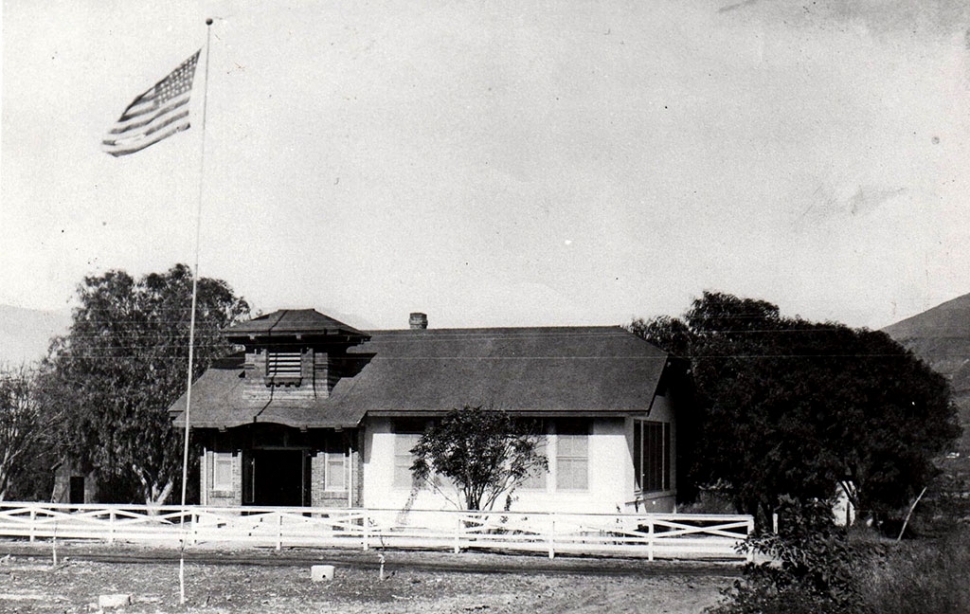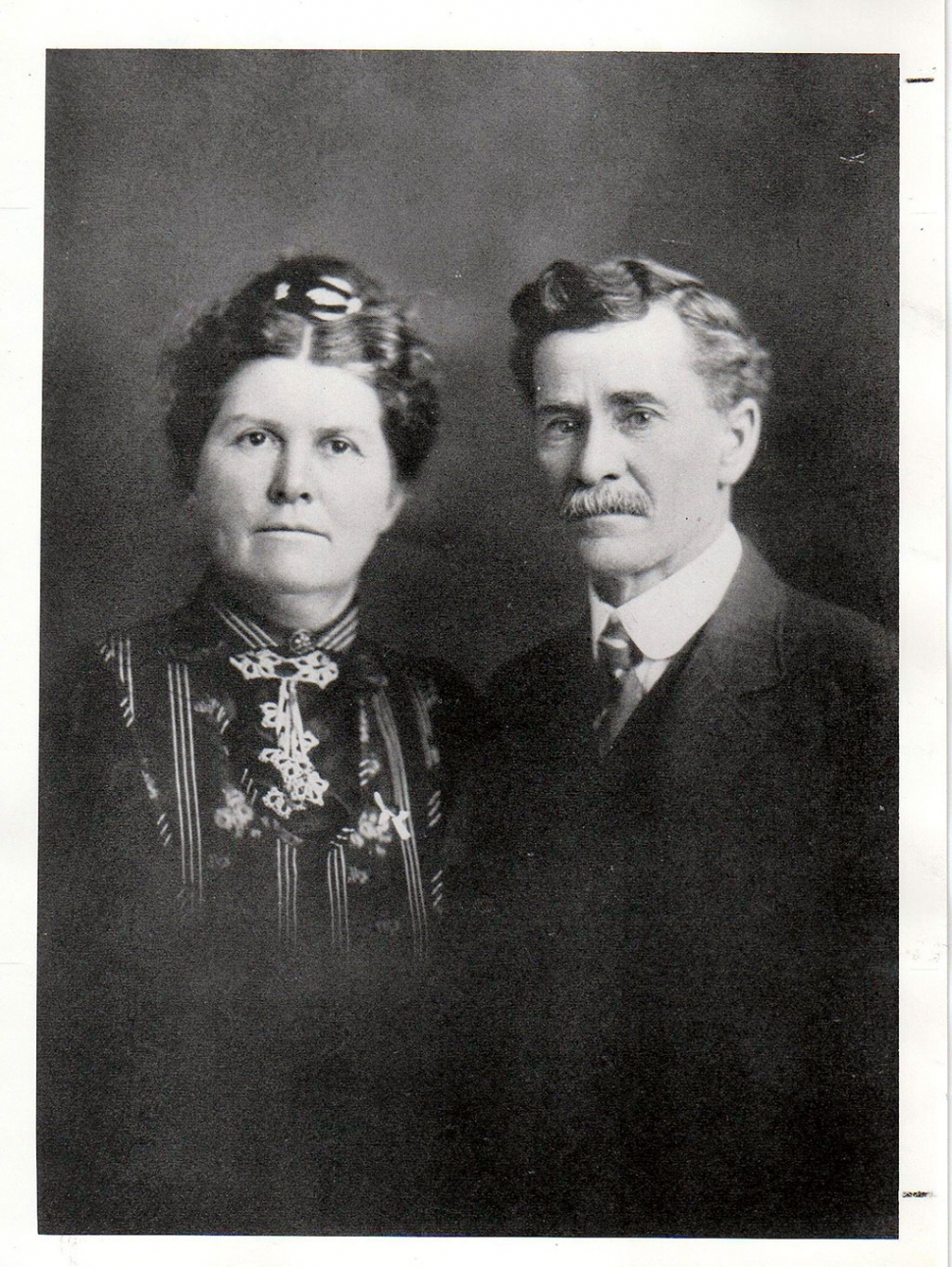
A gathering held in Bardsdale in 1890. The crowd is looking across the Santa Clara River towards Fillmore.

Willow Grove School.
[Story & photos courtesy Fillmore Historical Museum]
Mrs. George King, known as Hattie, was born Harriett Busick in El Dorado, California, the daughter of a pony express rider. She came to Bardsdale at age 12 to live with her aunt, Mrs. S. A. Guiberson. She married George King, who was property agent for Thomas Bard, in 1896. Together they had two daughters, Ona and Agnes.
Mrs. King had many interests but two were the Women’s Christian Temperance Union (when she registered to vote it was as a member of the Temperance Party while her husband was a registered Republican), and education. She financed the construction of building that was used for the first high school in Fillmore while the permanent building was completed.
This is an excerpt from a History of Bardsdale Mrs. King wrote in either 1915 or 1922.
An Excerpt from The History of Bardsdale By Hattie Virginia King (1915)
. . .In these early days of Ventura County, before Bardsdale had a name, there were trials, seen and unseen, to endure. The county was infested with thieves and outlaws, and the settlers had to watch their stock, especially their horses, night and day or they were driven away. The settlers finally had a meeting and decided upon a plan to catch these thieves. The decided each one would watch and shoot the first man they caught driving away stock. The men patiently watched their stock, while women and children bared [sic] the doors and also watched, in daytime, with loaded guns. The time came. One man was shot and killed, several wounded and the horse thieves quit coming. Then the settlers had another trial when, as they supposed they were settled on government land, they were driven off by the Spanish grant owners -- period. Many of them went away. But a few stayed and fought it out in the courts and got their land. It was proved the grant owners were claiming twice as much land as really belonged to them. The troubles over water, and troubles went on until that terrible crime was committed the murder of Tom More, the grant owner, 1877.
After the death of Tom More, his sons, the More brothers, farmed the land that is now the Bardsdale tract. Wheat and barley were raised. The Bardsdale land was assessed in 1876 at $9.00 per acre. It was not until January, 1887, that the Bardsdale tract was opened for settlement. After the death of More, Thomas R. Bard bought the land of the More heirs, held it several years, then sold 15,000 [acres] to R. G. Surdam, who divided the land into small tracts and began to colonize. This was in January, 1887, just 35 [years] last January. The only buildings now standing in the Bardsdale community that were standing when Bardsdale was opened for settlement are the houses of John Burson, the first home of the writer, the home of Mr. Lou Henry, the second home of the writer, and the two houses on the More place where Tom More was shot. ...
The first and second year of Bardsdale's life, things was [sic] lively. Mr. R. G. Surdam did everything in his power to advertise the place, and when the railroad was finished through the valley he bought a large bus that would seat 18 persons comfortably and hired a driver and met each train. For awhile, he had the local [train] to Santa Barbara stop two hours in the morning, when he would take as many as his bus would hold on the drive, first to Mr. G. W. Edward's, where the only orange orchard was located, inviting them to partake of all the oranges they could eat, then to the Bardsdale town site [where] with the assistance of his map [he] would point out the principle business houses, churches and school house. He also had a collection of news which passed away the time in showing the tourists. If anyone wanted to stay over and investigate, all arrangements were made with an entertaining housewife to entertain them. Strange to say, many people came and the place was settled quickly. But there were many changes. Some came only staying a few months, others a year or two, and going nearer the city. For some time the Bardsdale bus met the train, and it was the delight of the young people of the county to take that ride as well as the tourists. The bus was around Bardsdale for a number of years, and the young people often took party rides in it.
Mr. R. G. Surdam was a very kind-hearted and liberal man. He gave away nearly all he made and all the children and young people were his friends. The first Christmas after Bardsdale was open, the Christmas tree and exercises were held in the Willow Grove school house, and Mr. Surdam gave everyone present a nice Christmas gift. It was estimated that he spent $500 on Xmas presents. The boys he gave drums and horns, and the young men pocket knives, the little girls dolls, the big girls scrap book and autograph albums, and the ladies woolen dresses. Everyone, of course, had a joyous Christmas. Mr. Surdam loaded the tree with candy and everything good and acted as Santa Claus. So after that, the children called him Santa, and it pleased him. There was nothing too good for the children, and as long as he had money he used it freely. . .



